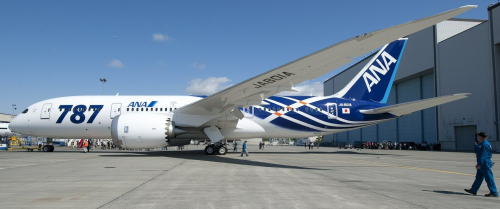
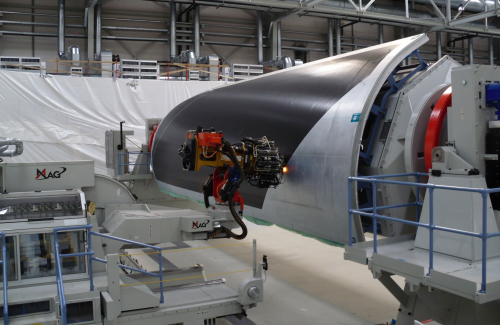
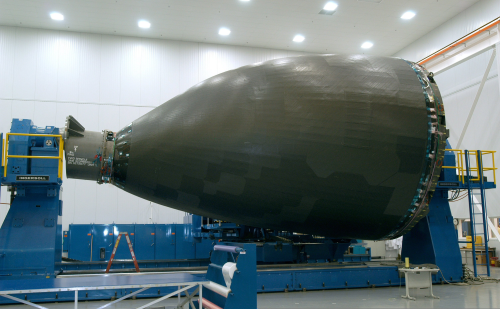
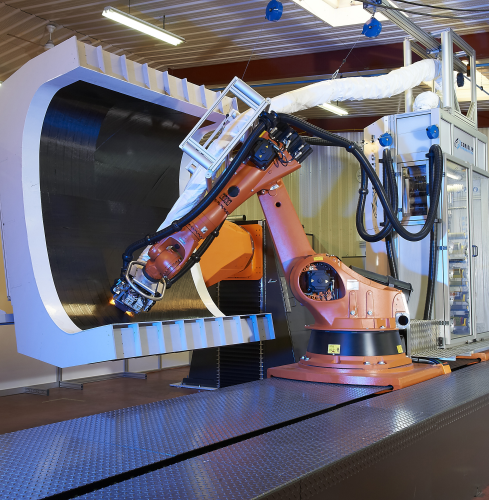
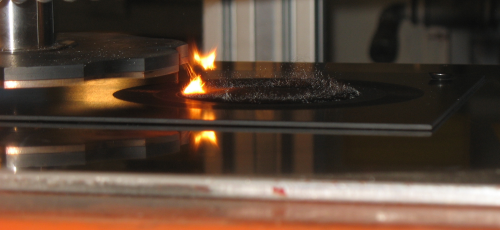
Repairing the composite parts that have been produced for jet airliners up to now is a well established art, but repairing reinforced plastic fuselages is likely to be, as they say, a whole new ball game. With both leading commercial jet airframers now having adopted composites for the fuselages of their latest aircraft – the Boeing 787 and Airbus A350 XWB, (although Hawker Beechcraft has shown the way with the Hawker 4000 [formerly Horizon] business jet) – airframers, regulators and repairers are facing a major repairs challenge.
There are uncertainties surrounding the repair of these internally-pressurised, humanity-containing tubes that are arguably the most safety-critical part of an aircraft and simply cannot be allowed to fail or be compromised. Fuselages are very different from the planar thin-skinned, honeycomb-cored structures that have been the mainstay of aircraft composite repair shops to date. They have pronounced curvature and utilise monolithic laminate that can be thick in some places. Being generally filament wound or tape laid they rely, for at least part of their integrity, on long continuous fibres. And, most significantly, they are engineered to withstand constantly repeated cycles of elevated internal pressure.
Clearly, with structures that are protecting occupants flying six miles high, repairs must be qualitatively beyond reproach, offering the highest levels of assurance. However, given the variability inherent in this supremely tailorable class of materials, plus the diverse skill levels of repair technicians, achieving this consistently is difficult.
Answers not yet in place
Despite positive spin from the airframers, the industry is to an extent feeling its way on this issue and experts agree that not all the answers are yet in place.
Recently, for instance, the General Accounting Office (GAO), the influential watchdog over official policy in the USA, issued a report expressing concerns about the accelerating use of composites in aircraft structures. Highlighting repair issues, the GAO report cited:
- the difficulty of detecting damage;
- limited standardisation of composite materials and repair techniques;
- the level of training and awareness of workers handling composites; and
- a dearth of information on the longer-term behaviour of aircraft composites due to limited in-service experience so far.
Significantly too, the airworthiness authorities remain wary of bonded repairs and have been loath to certify them.
Boeing and Airbus may be somewhat over-optimistic in claiming that they either have answers to all these points or are well on the way to having them. Both assert that composite fuselages are in any case tougher than those of metal and will be more resistant to damage. However, experience suggests that some damage will inevitably occur, especially to lower fuselage sections which are vulnerable to impacts from baggage loaders, catering carts and other service vehicles. When this does happen, aircraft operators will require access to repair schemes that are fully developed, approved and certified.
Boeing, whose B787 Dreamliner entered service with Japan’s All Nippon Airlines (ANA) last year, says that maintainers can get an aircraft flying again after suffering ramp damage by using the same repairs they have traditionally used on metal aircraft – basically bolted metal patches. Bolted repairs have the advantage of being quick to execute so that they can often be completed within an aircraft’s normal turnaround period on the ground between flights. They are also thoroughly familiar to airframe repair technicians, who can carry out repairs using their normal tools and equipment.
Bonded vs bolted
While bolted patch repairs may appeal to airframe repair technicians throughout the world who have been brought up with metals, they are anathema to many composites specialists.
| While accepting that bolt-on repairs may be familiar and quick, we would prefer bonded repairs if the regulatory hurdles could be overcome. It’s certainly a shame to have to make holes [for bolts] in nice continuous fibre lay-ups. But bonded repairs are not yet accepted by the airworthiness authorities except, essentially, as a cosmetic fix. |
| Dr Christian Sauer, manager engineering, airframe related component services, Lufthansa Technik |
As one expert, Dr Christian Sauer, manager engineering, airframe related component services at leading maintainer Lufthansa Technik (LHT), told Reinforced Plastics: “While accepting that bolt-on repairs may be familiar and quick, we would prefer bonded repairs if the regulatory hurdles could be overcome. It’s certainly a shame to have to make holes [for bolts] in nice continuous fibre lay-ups. But bonded repairs are not yet accepted by the airworthiness authorities except, essentially, as a cosmetic fix.”
Acknowledging this bonding preference, Boeing has included an elementary type of bonded repair in its Structural Repair Manual (SRM) for the B787. Its temporary ‘band aid’ repair system can get an aircraft flying again quickly after suffering minor damage that might otherwise cause a grounding. Essentially, a composite patch is used instead of metal and through-bolting is avoided. Boeing says its system enables patch repairs to be made in as little as half an hour, compared with the 24 hours or more a classic bonded repair might take.
In use, a pre-cured composite patch is epoxy bonded to the outside of the damaged area and a chemical heat pack is applied to cure the resin –- a formulation that has been selected for its ability to cure at relatively low temperature. The repair is designed to be applied at the gate if necessary and to restore sufficient strength to enable the aircraft to be cleared for flight. It is primarily intended for instances of light damage and not for more serious cases where load path integrity is at stake. A more permanent repair can be made later, typically when the aircraft is due for a major maintenance check inside a hangar where conditions can be controlled.
That later more permanent solution is likely to involve a bonded material insert or ‘plug’, as distinct from a patch. While favoured by the composites community, such repairs take longer to perform and are likely to result in unscheduled down time. Flush repairs having scarfed joints, in which tapered edges spread loads over a substantial contact area, are inherently time consuming. They require painstaking preparation, careful tailoring and lay-up of composite plies, a period of heating and adequate cure time. However, for the Federal Aviation Authority (FAA) and European Airworthiness and Safety Administration (EASA), the main reason for witholding certification of bonded repairs is the lack of certainty over bond quality.
As one industry insider succinctly put it: “The difficulty at present with a repair bond is knowing exactly what strength you’ve got. There‘s no sure way of testing a bond’s strength without breaking it, and one has to rely on coupon or sample tests, which might not be fully representative.”
Similarly, LHT’s Sauer, while applauding airframer efforts to validate large bonded repairs on primary aerostructure, has questioned whether such repairs, no matter where in the world and by whom they are carried out, can uniformly meet the required standard. This, he told us, is the crux of the difficulty in certifying them.
At the heart of the matter is variability, in terms both of the materials used and of technician competence. Because composites are, by definition, a mix of different materials drawn from an ever expanding palette of possibilities, precisely matching the original lay-up in the repair might not be practical. Maintenance organisations are rarely equipped to manage the diverse order lead times, storage requirements, processing regimes etc to do this. At the same time, repair technicians vary widely in their backgrounds, experience, training and aptitude for the work. And, while repair shops must be certified to carry out composite repairs on aircraft, individual technicians currently do not have to be.
Great efforts are being made to overcome these disadvantages so that bonded repairs to fuselages can meet airworthiness criteria. Acknowledging the difficulty of matching precisely in a repair the original ‘as new’ composite, Boeing has researched and specified a single compatible carbon prepreg repair composite which it says can be applied throughout the B787 fuselage. This, it says, avoids the need for maintenance departments to stock and manage a range of materials.
It is harder still to overcome the variability associated with manual processes carried out by human beings. Many in the industry believe that improved training is a key part of the answer to this. One such is Michael Hoke, president of Abaris Training Resources Inc, who identifies the incorporation of thick solid laminates in aerospace structures (including door and window surrounds in fuselages) as one of the drivers for this need. Dealing with solid laminates that may be up to an inch and 75 to 100 plies thick is, he notes, very different from repairing the more usual face sheets, perhaps 0.05 in thick, on flatter sandwich structured components. Technicians will need to master heat application methods requiring special hot bonders and backside access for thermal curing, plus slower ramping to ensure heating throughout the laminate.
A related issue is the size of the repair. Even a small area of damage might require an extensive repair because of the need with a scarfed joint to ‘step out’ from the damage site in order to achieve the required through-thickness chamfer gradient. Technicians will need considerable training and practice before they have the skill and finesse required to prepare and carry out scarfed repairs that are both strong and leave an aesthetically pleasing flush surface finish. Many believe that, to convince the airworthiness authorities of the efficacy of bonded repairs, training will have to be accompanied by a system of certification of individual repair technicians.
Another counter to variability is the provision in that airframe maintainer’s ‘bible’, the SRM, of a range of approved repairs that are described in detail. For the B787, Boeing is including solutions ranging from bolt-on/glue-on patch repairs, through simple bonded repairs, to large (up to 1 m2) repairs involving replacement material bonded at high temperature. The latter would normally need to be carried out under controlled environmental conditions in base facilities. More repairs will be added to the SRM as they are developed and approved.
Technology prospects
Despite systemic improvements, variability and lack of certainty about repair quality are likely to remain difficult issues for some time. Indeed, there is a growing belief that manual processing cannot be the answer and that ultimately it will have to be superseded by automated solutions. Only these, it is argued, can deliver repairs that meet the required standards consistently and reliably.
Matthew Beaumont, Head of Operations, Composite Technologies, at EADS Innovation in Germany sees automation as a way to alleviate concerns about bonded structural repairs. He believes that present practice relies excessively on bolted repairs and, in a telling quote, has said: “As a developer of advanced composite structures, it hurts me to even think about drilling myriad holes through these very optimised and precisely designed and manufactured components.”
EADS Innovation has been working on automation that might eventually carry out an entire repair cycle encompassing damage detection, surface preparation, repair patch creation, patch application and finally quality assurance checking. Partners in this programme to develop repair robotics include Lufthansa Technik, Eurocopter and Cassidian Air Systems.
Meanwhile, the German Aerospace Research Centre DLR has been investigating the automation of resin infused repairs. The aim is to develop scarf repair capability including damage removal by computer-controlled milling, impregnation of a dry preform laid into an excised site, and subsequent cure. DLR claims the method is particularly appropriate for curved areas, reducing complexity and avoiding the need to produce special tooling.
Other companies are focusing on particular parts of the repair cycle. Laser specialists cleanLASER and SLCR, also in Germany, are separately working on systems to prepare repair sites. CleanLASER’s bond surface pre-treatment for carbon fibre composite is said to result in superior bonded repairs without recourse to abrasives or chemicals, a laser-based optical machining system being used to remove damage ply by ply. SLCR, meanwhile, is working with UK concern GKN Aerospace to develop their own automated facility for preparing a repair site.
GKN Aerospace’s John Cornforth, Vice President Technology, describes their laser ablation solution as a non-manual, contact-free process able to remove material from a repair site by ablating away the resin, leaving brittle fibres that can be brushed out afterwards. Damaged material is removed forensically, leaving a site prepared to precise dimensions for a tailored replacement plug or patch. No force or vibration is applied to the structure during material removal so there is no adverse effect on its strength or integrity. Cornforth reports promising results from the programme’s first phase, in which the partners produced a prototype equipment able to prepare a repair site. This prototype is now installed at GKN Aerospace’s Composite Research Centre at Cowes, Isle of Wight, UK.
A second programme phase, now under way, will see the equipment developed further to cope with more complex damage sites where there may be underlying obstructions, such as frames and stringers. The laser will be able to prepare sites for stepped or constant angle scarfed repairs, taking account of these features.
Cornforth told Reinforced Plastics that, although the technology is in its infancy, he envisages the eventual incorporation of a mix of repair capabilities within a single automated cell. Laser ablation would be linked to CAD imagery of the original part so that pre-manufacture repairs could be prepared. Various non-destructive evaluation (NDE) technologies could be included for rapid damage detection and assessment.
Another area ripe for technological advance is the heating and cure part of the cycle. One particular focus is the further development of conventional hot bonders, such as those produced by HEATCON Composite Systems and Zymac Fabrications. The latter, for instance, has produced heating blankets that incorporate separate small thermal cells so that, irrespective of what structural heat sinks lie behind a large repair site, more even heating is provided throughout the repair material. Meanwhile, HEATCON has developed a stretchable heating blanket for use around curved surfaces.
Alternative heating methods, such as induction heating and incorporation of heating elements within composite repair patches, are under investigation. Ground support specialist Sunaero Aviation Inc, for instance, is developing a hand-held infrared device intended to speed up repair cure without subjecting the material to excessive heat. A version being developed for carbonfibre composite could supplant the use of heating blankets in certain applications. Other possibilities include the use of microwave-coupled heating blankets and repair patches that incorporate a conductive mesh so that the patch itself can be heated directly.
A further technological focus is that of managing paint finishes. Removing paint from large composite surfaces is tricky because the chemical strippers routinely used on metal aerostructures are apt to attack not only the paint, but also the underlying composite. Paint manufacturers have sought to counter this with finishes that include between the primer and top coats an intermediate layer that will dissolve in mild strippers that do not degrade either the primer coat or the composite. Even so, where damage has occurred, repair sites will still require manual sanding.
Once more, however, lasers might offer a solution. Lufthansa Technik has been investigating the use of a laser on a control head that moves over the fuselage surface. Modern lasers, says LHT, can strip paint from large areas at hitherto unachievable rates while recognising which layer is being removed. This raises the prospect that future robotic systems will be able to strip anything from a modest repair site to an entire composite aircraft. Although LHT has been obliged to put this work on hold for the moment due to a company decision to close its Hamburg painting facility, the stripping concept is still promising and may be taken up elsewhere.
Detecting the damage
A particular issue with composites is the difficulty of establishing, after an impact, whether the laminate has suffered damage without there being any sign of it at the surface. Unlike metals, which show they are ‘hurt’ by exhibiting dents, composites can spring back from low-energy impact such that damage several plies down within the laminate can be hidden behind an apparently unharmed surface.
Reliable and speedy detection of damage on the flight line will require compact, portable NDE equipment. Boeing has been developing a hand-held ultrasonic ramp damage checker which, according to the company, will detect sub-surface laminate damage with sufficient clarity to enable technicians to say whether or not an aircraft can be cleared to fly. Similarly, Norwegian ultrasound specialist DolphiTech is working with EADS Innovation Works on a hand-held ultrasonic sensor said to be able to see through 8-10 mm of composite material to reveal defects within the laminate. The partners aim to embody a scanning camera system within a practical mobile NDE tool.
A solution that combines monitoring with the induction heating of composite repairs has been the subject of a European Union funded programme called INDUCER (Induction Heating and Health Monitoring Solutions for Smart Aircraft Maintenance Using Adapted Composite Patches). Within the programme, TWI (formerly the Welding Institute in the UK) and GMI Aero have collaborated on the concept of smart patches in which a magnetostrictive sensor mesh embedded within the repair lay-up serves both to heat the repair for cure purposes and, in later monitoring mode, to react magnetically to stresses. Thus, it is likely that stresses incurred during cure and then the on-going structural integrity of repairs during service can be monitored using the single mesh ply approach. .
Other developments address the difficulty of knowing, should damage occur, whether the affected laminate is ‘clean’ or has been contaminated, for example by hydraulic fluid or fuel. Even slight contamination can seriously impair a bond, and a number of companies, including Lufthansa Technik, are working to develop reliable contamination detectors.
Still, technology cannot provide all the answers. Probably there will always be times and instances where skilled manual skills are required, placing a premium on effective training and hands-on practice. Nor will the need for education apply only to composites technicians. It will, for example, be important to impress on both air and ground crews the importance of reporting any accidental contacts, no matter how apparently slight, between the fuselage and other objects so that the impacted area can be inspected for damage. In terms of ground personnel, this will be difficult as there will always be drivers of service vehicles in far corners of the world who neither know nor care whether the fuselage is composite or metal and may fail to report ‘bumps’ that result in no visible damage.
For the present at least, uncertainties remain. A big question is what happens when a major repair is needed that is outside the scope of the SRM? Almost inevitably, this will be an aircraft-on-ground (AOG) situation and therefore time critical. One can be sure that, in the early stages of a new aircraft’s service when overall fleet size is small, airframers and their partners will be highly proactive in supporting operators who face this situation. They will bring all their forces to bear in fielding repair schemes as rapidly as possible.
Independent maintainers will, ideally, be given open access to the manufacturer’s stress and other calculations as well as the relevant experts, so that they too can develop viable repairs. No doubt the communication channels between maintainers, the design authority (airframer) and perhaps the airworthiness authorities will be relatively unobstructed in these early stages. But this situation could change as fleet size builds until, eventually, there are hundreds of aircraft with composite fuselages in service.
The airframers expect that the evolution of repairs, along with the associated infrastructure, will be sufficiently rapid to keep pace with fleet growth. Only time will tell if this view is justified. Clearly, the move to composite fuselages for commercial jets is a bold one that should reap dividends through reduced aircraft weight and fuel usage – but only if maintainability risks can be managed successfully.
Biggest risk
Arguably, the biggest risk of all is that the structurally sound fuselage that emerges newly built from the aircraft factory can have its integrity progressively degraded over a history of successive repairs. No-one knows how many repairs of various types a fuselage can sustain before its strength is so compromised that there is a risk of failure – at worst an explosive decompression at altitude. The dreadful consequences of this became all too evident to British planemaker DeHavilland at the dawn of the passenger jet age more than half a century ago. In that case it was metal fatigue that led to the catastrophic loss of several of DH’s boldly conceived Comet aircraft. Admittedly, a composites failure is likely to be more progressive and less catastrophic, though with high-flying pressurised fuselages one can never be quite sure.
Fortunately, risk management has moved on since the Comet days. Nevertheless, minimising risks associated with fuselage repairs will, over the next several years, be one of the most significant challenges for composites. Clearly, it behoves all concerned – particularly airframers and their partners, aircraft operators, airworthiness regulators and maintenance/repair organisations – to tread carefully, maintain open lines of communication and collaborate closely so that the high reputation of this remarkable class of materials is maintained. ♦
This feature was published in the May/June 2012 issue of Reinforced Plastics magazine. To obtain your free copy of each issue of the magazine please complete the registration form.





